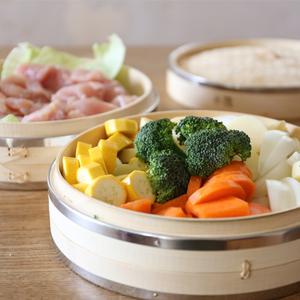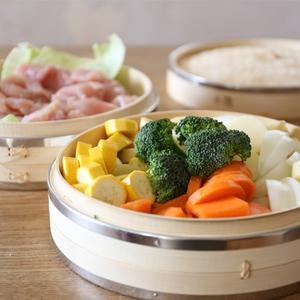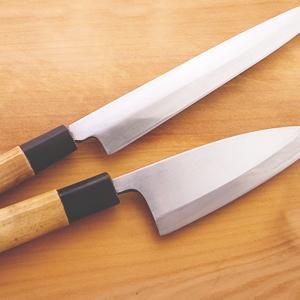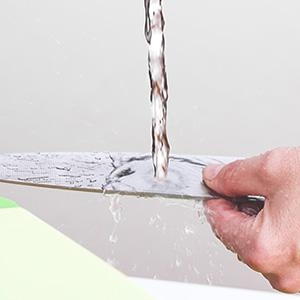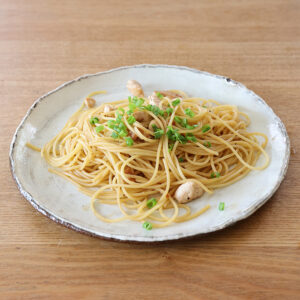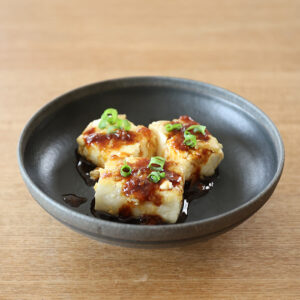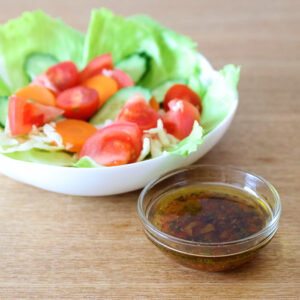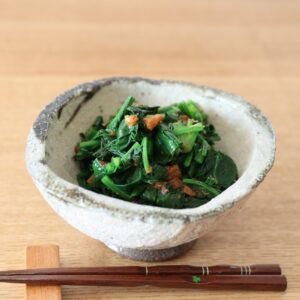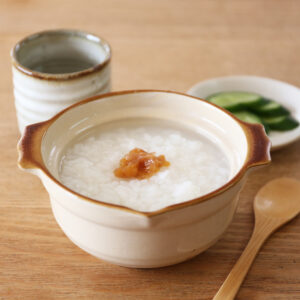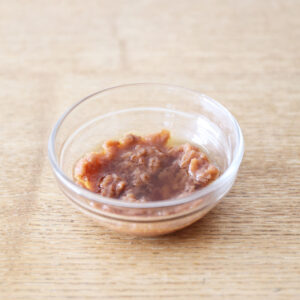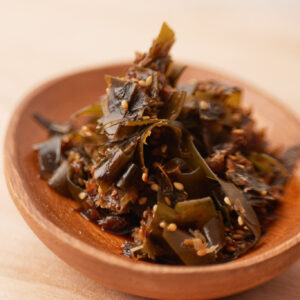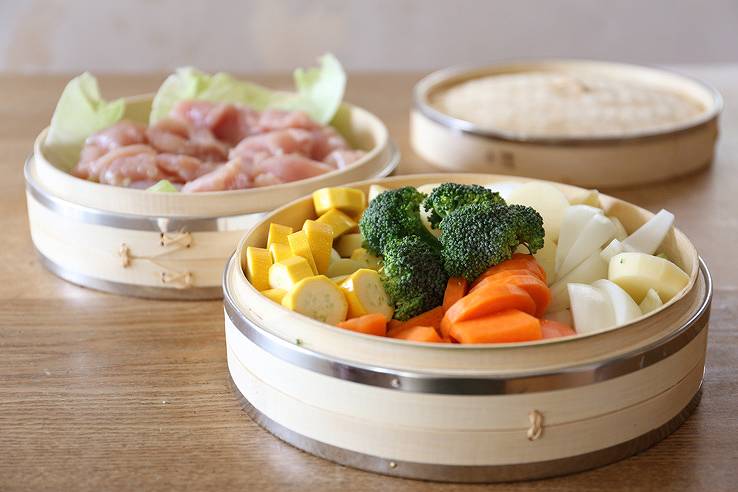
In a household with small children and working parents like mine, we prefer to handle housework efficiently and with few hands as possible.
After finishing work and pick up my children from nursery school to home, it is time to make dinner at high speed. The dinner is a dish that is easy to cook without time-consuming.
Even so, I do not want to neglect the nutrition intake for my growing children.
In such busy days, the traditional cooking tool “Seiro” (steamer) came as savior.
You can make a dish by just cutting vegetables or meat, put and steam it for 10 minutes.
Making steamed dish from seiro is very easy.
You can put the steamed dish directly to the table as it is with the seiro, so it can reduce the dish laundry.
This time, I will introduce some steamed cooking recipe using seiro that can be easily made even by busy people.
 Content List
Content List
- Steamed Dish Recipe Using Seiro
- 1. Steamed Vegetables
- 2. Mochi Textured Sweet Potato Steamed Bread
- 3. Steamed Pork and Vegetables
- 4. Chawanmushi (Japanese Steamed Egg Custard)
- 5. Steamed Sticky Rice with Sweet Potato
- 6. Simple & Delicious Shumai
- Warm up Rice without Using Microwave!
- Seiro’s Frequently Asked Questions
- Seiro’s Recommended Products
Steamed Dish Recipe Using Seiro
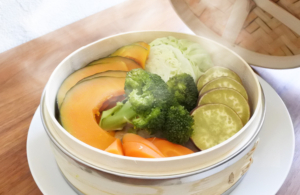
Steamed Vegetables
Ingredients
- appropriate amount Your Favorite Vegetables
Instructions
- Wash lightly the seiro with water, and bring lots of water into boil in a pot. Put the seiro above the pot filled with water.
- Cut your favorite vegetables, can be sweet potato, potato, broccoli, etc. Set and arrange the previously cut vegetables in the seiro.
- If you use cooking sheet, kitchen paper, or steaming cloth, it will be less dirty and easy to take care with after steaming.
- When the water at the pot comes to a boil, set the vegetables in the seiro.
- Depending on the type of vegetables, it will be steamed perfectly after 5-10 minutes when the fire goes through.
Notes
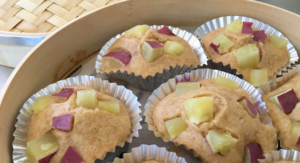
Mochi Textured Sweet Potato Steamed Bread
Ingredients
- 120 g Wheat flour
- 1 Egg
- 1 tbsp Baking powder
- 40 g Sugar cane
- 100 cc Milk (soy milk or water are also OK)
- to your preference Sweet Potato
Instructions
- Cut the sweet potato in square cut and soak it in water.
- Put and mix well all the ingredients except the sweet potato in a bowl.
- When mixed, add the cut sweet potato and mix further.
- Pour the dough into aluminum cups, and set it in the seiro.
- Steam it for 10 to 15 minutes in high-temperature steam.
- You will know that the dish is finish when you stick a bamboo chopsticks at the dough, and the dough does not stick.
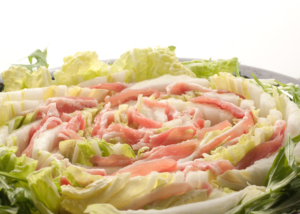
Steamed Pork and Vegetables
Ingredients
- 180 g Pork belly meat
- to your liking Cabbage
- to your liking Salt for seasoning
- 2 tbsp Sake
- to your liking Ponzu
Instructions
- Cut the pork belly into 5 cm long, soak the meat with salt and sake in the refrigerator for 30 minutes.
- Keep the shredded cabbage well drained with water.
- Wash lightly the seiro with water, and bring lots of water into boil in a pot. Put the seiro above the pot filled with water.
- Lay a cooking sheet on the bottom of the seiro, and pile up the cabbage and pork belly alternately in layers.
- When the water comes into a boil, cover the seiro with lid and let it steam for about 10 minutes.
- Once steamed perfectly, enjoy it together with ponzu.
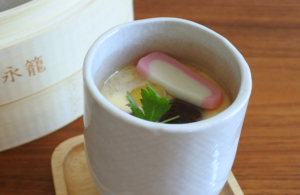
Chawanmushi (Japanese Steamed Egg Custard)
Ingredients
- 2 Egg
- 400 cc Dashi stock
- to your liking salt
- 40 g chicken breast
- 4 pieces Shiitake mushrooms
- in an appropriate amount Ginkgo nut
- in an appropriate amount Kamaboko
- in an appropriate amount Parsley
Instructions
- Break the eggs into a bowl and add the dashi stock on it. Mix well and strain it with stainer. (Please adjust the taste with salt at your liking).
- Cut the chicken into bite-size pieces. Cook it into a boil and drain the water well.
- Cut the shiitake mushroom and peel the thin skin of ginkgo nut.
- Pour the ingredients except for the parsley to the bowl. Crush any foam on the surface with a bamboo skewer and so on.
- Steam for about 10 minutes. The dish is steam perfectly if you see a clear soup on the middle. If it still have uncooked side, let it steam for few more minutes.
- Complete the steamed chawanmushi with parsley on the top of the dish.
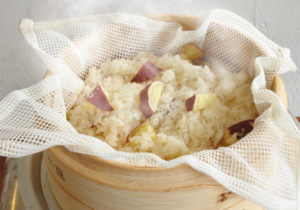
Steamed Sticky Rice with Sweet Potato
Ingredients
- 1302 g Glutinous rice / sticky rice
- ½ piece Sweet potato
- 130 cc Dashi stock (or water)
- 50 cc Sake
- in an appropriate amount Sesame salt
Instructions
- Make sure to soak glutinous rice in water for 6-8 hours.
- Cut the sweet potato into 1.5 cm cubes and soak in water for a while.
- Drain well the water of the soaked rice. Add sake and dashi stock to the soaked rice and mix well.
- Boil a lot of water in a pot
- Lay a steaming cloth on the bottom of the seiro, spead the rice above the cloth, and put the sweet potato on top.
- Steam for about 40 -50 minutes, and finish it with sprinkled sesame salt.
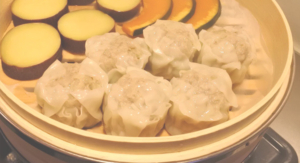
Simple & Delicious Shumai
Ingredients
- 200 g Minced pork
- less than ½ teaspoon Salt
- 150 g onion
- 80 g spring onion
- 10 g ginger
- 15 pieces dumpling wrappers
- in an appropriate amount cabbage
Instructions
- Chop the onions, the spring onions and ginger.
- Put the minced pork and salt in a bowl and mix well.
- Add chopped onion, spring onion, ginger, and mixed pork into the mixture of Seasoning.
- Make the dumplings. Add 2 teaspoons (or at your liking) of meat mixture in every dumpling wrappers, wrap it well. (The amount finished dumplings varies to the amount of meat mixture).
- Lay the sliced cabbage on the bottom of the seiro, and arrage the dumplings on the top.
- Set the seiro in the pot and steam it for about 10 minutes in high heat.
Warm up Rice without Using Microwave!
If you warm up steamed rice using seiro, it will always have a plumpy texture and delicious even if it gets cold.
The reason is because the heating principle of microwave and seiro is different.
Microwave heating will warm up the moisture, while seiro will warm up the whole ingredient.
The steamed vegetable cooked with seiro are not watery, and it still delicious even if they are cold.
In the same reason, meat buns are also definitely delicious.
With just a little time and effort, you can taste delicious rice different from warming up with microwave.
Seiro’s Frequently Asked Questions
About How to Use
- How many stages of seiro (steamer) can we stack together to steam a dish?
- It depends on the ingredients inside, but it is up to 3 stages if you use pot available in your household.
As for the stacking order, the upper one is the one with shorter steaming time. Also, if you want to avoid the dish to steamed too long, put it on the top.
- Do you have any tips for drying the seiro (steamer)?
- Place the seiro stand diagonally in a well-ventilated place, occasionally turn it back and forth to dry it faster.
If you dry it in a flat place, there is some possibility that the part of seiro that touches the ground directly will have mold. So please be careful with that.In addition, exposure to direct sunlight causes cracks. Therefore, let’s dry it in well-ventilated place with no direct sunlight.
- When using seiro, can I use it together with the pot I have at home?
-
Yes, you can. As long as the pot’s diameter is 1 or 2 cm smaller than the seiro’s diameter, you can put your seiro above the pot as it is. However, if the pot is the same diameter as the pot, it may get stuck and burned.
We recommend you to put lots of water into the pot. If the seiro is too big, the steam will leak and doesn’t steam perfectly. But if the seiro is too small, it will sink to the pot.If the size of the pot does not match the size of the pot, it is better to use a steamer board.
Click here to see products for “steamer board” →
- Can you stack the same size of Bamboo-made seiro and Japanese Cedar-made seiro together?
- No, you can’t. Because each material have different specifications, you can’t use different seiro material even if it is the same size. Therefore, please use the same seiro material.
- Can you stack the same size of Chinese-style seiro and Japanese-style seiro together?
-
No, you can’t. The reason is that different seiro have different specifications, even if they are the same size.
As specifications such as height are different, the dish will not steam perfectly.
- How is the durability of seiro?
- It depends on the frequency of use, but you can keep it for a long time by using it correctly.
Here’s some point to avoid:
・ When you start using it, use the seiro after wash lightly with water.
・Don’t let the water in the pot runs out / let the fire too strong. That may burn the seiro on the bottom.
・ After using it, put it in a well-ventilated place and dry it well.
- What can I cook using Seiro?
- You can put ingredients that will have lots of moisture like meat, fish, or shumai (steamed dumplings). You can also steam vegetables like cabbage. Also, it is okay to lay flat plate and steam it together with a dish.
By not putting the ingredients directly on the seiro, it can prevent the ingredients to stick, leave a smell to seiro, and prevent the infiltration of water such as meat juice, so it will be easier to clean up later and will last longer.
- I want to use seiro for a long time without burning. Please give me some tips!
- Here are some main cause that causes seiro to burn:
1. By putting the seiro directly at the top of the pot.
2. By not washing the seiro with water before using.In other words, please keep the seiro wet before use and it is recommended to use steamer board to keep using the seiro for long period.
- How much rice can you steam in one seiro?
- Let’s calculate how much rice can we cook at the “1 stage” of Japanese-style seiro.
・ Small size (diameter 15 cm) : 1302 g rice
・ Medium size (diameter 21 cm) : 1736 g rice
・ Large size (diameter 24 cm) : 2604 g of rice
・ Super large size (diameter 30 cm) : 3473 g of riceThe steaming time varies depending on the rice you use. (Glutinous rice / sticky rice takes 40 – 50 minutes, and rice koji takes 35 – 40 minutes)
In case for Chinese-style seiro like Shouhou’s Seiro and Tenshan’s Seiro, please reduce 434 g from the amount above for every size available.
About Recommendations
- What seiro (steamer) product do you recommend for first time buyers?
- In Kawashima The Japanstore, we have seiro made with Bamboo, Japanese Cedar, and Japanese Cypress (Hinoki). Even the material is different, it has the same steaming degree and usage method.
If you’re buying it for the first time, Bamboo-made seiro is recommended for its price and durability.
Japanese Cedar-Made Seiro → The price is affordable. When steamed, it has the smell from cedar. If you like the scent of wood, this cedar-made seiro is recommended for you.
Bamboo-Made Seiro → The price is affordable. The durability is higher than cedar-made seiro. Have weak aroma even when steamed.
Japanese Cypress-Made Seiro → It is the most expensive of the three materials. Japanese cypress has fine wood fiber and beautiful wood grain. You can use it for a long time because of its strength and durability.
- Where the seiro is produced?
- The origin of seiro is the origin of Chinese food, which is China.
One of the seiro brand in Kawashima The Japanstore is “Shouhou”, it is a seiro made by top craftsmen from carefully selected materials. Shouhou produces and sells Chinese cooking utensils and table wares, it has gained trust starting from a local Chinese restaurant to the cooks of all over Japan.
Click here to see products for Shouhou’s Seiro →
- What is the different of Chinese-style seiro and Japanese-style seiro?
-
Chinese-style seiro is a seiro you can use to make shumai (steamed dumplings), or steamed vegetable, and serve it on the table as it is. The seiro can be stacked together up to 2-3 stages.
As for Japanese-style seiro, it’s perfect to make chawanmushi or steamed rice because it has more depth than the Chinese-style seiro. In addition, unlike Chinese-style seiro, the Japanese-style seiro have a lid that makes the moisture hard to escape. So it is necessary to add cloth to prevent any water droplets from falling to the dish.
- What seiro (steamer) size do you recommend for first time buyers?
- We recommend you to have the 2 stages of small size seiro with diameter of 18 cm.
Small size with diameter of 18 cm is the right size for steaming chicken or fish fillets. Also, seiro is an attractive cooking utensils you can use to cook many ingredients at the same thing. So, please experience to steam different ingredients at once with the fun and convenient seiro.If you get used to it, it is also recommended to have the large size seiro with diameter of 24 cm. This size is perfect to steamed one whole fish or make steamed rice. You can steam it together with the plate so you can broaden your cooking variation.
About How to Take Care of Seiro
- I worried about the wood smell from the seiro..
- Seiro is a cooking utensil made with natural materials. Therefore, at the beginning of use, the wood smell may make some people feel anxious.
The wood smell will weakened as you use it. But if you have a concern about the smell, you can steam it without any ingredients inside to make the smell disappear quickly.
- Can I wash seiro with dish detergent?
- To wash the seiro after use, please wipe it using cloth dampened with hot water without using detergent.
Since seiro is an unpainted wooden product, washing seiro with running water can cause mold.
However, if you have a concern with any stains, it is okay to wash it with dish detergent. But please make sure to wash off the dish detergent with water.
Put the ingredients on a plate, kitchen paper, etc. before put it into the seiro to prevent dirt. Also, please do not use the dishwasher because it can causes color distortion.
- There is a mold in my seiro!
- If mold has grown, wash off the mold and apply boiling water to disinfect it. Mold causes erosion into the fibers of the wood and can’t be removed by washing.
If you have a concern with the mold, please use cooking sheets or plate when placing the ingredients. All black dots attached to the wood are all molds.
Please make sure to dry well the seiro after use.
- Where should I keep the seiro?
- After use, store in a well-ventilated place and in a completely dry condition. If it is stored in a poorly ventilated plastic bag etc. it will cause mold and distortion.
If you do not use it for a while, wrap it in newspaper before storing. Do not wrap it in a plastic bag, as it may cause distortion and insect bite as well as mold growth.
Just hanging on the wall or just putting it in the kitchen is wonderful as an interior.
- Why the hot water inside the pot turned brown after being used?
- That is because the astringent substance from Bamboo has come out.
At the beginning of use, the hot water may turned brown because of the astringent substance. But it will disappear as you use it. But if you have a concern about the brown water, you can steam it without any ingredients inside the seiro to make the color disappear quickly.
Even if the bamboo-made seiro have an astringent substance, it will not affect the steamed ingredients so you can consume it without worry.
Seiro’s Recommended Products
So, how’s the recipe?
Unlike boiled or grilled ingredient, slowly steamed ingredients do not lose its nutrition and flavor.
Nowadays, microwave ovens have become a common cooking tool in our daily life.
But in the past, we have been always used the steamer recipe like this way.
Being used to the most convenient tool, people forgot the warmth from the wood.
It is “seiro” (steamer) that makes us notice the original taste from ingredients by steaming it.
Making a dish for welcoming guests are also surprisingly easy with steaming.
There are likely to be more opportunities for success using seiro.
In Kawashima The Japanstore, we handle some recommended products for seiro, steaming board, and steamer cloth.
Starting with consuming steamed food, why not spend an enjoyful healthy life style?

